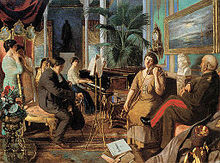Mehisti Hanım
| Mehisti Hanım | |||||
|---|---|---|---|---|---|
 "Beethoven in the Harem", 1915. Mehisti is thought to have been one of the two women listening with rapt attention[1] | |||||
| Born | Atiye Akalsba 27 January 1892 Yongalık, Adapazarı, Istanbul, Ottoman Empire | ||||
| Died | c. 1964 (aged 71–72) Middlesex, London, England, United Kingdom | ||||
| Burial | |||||
| Spouse | Abdulmejid II | ||||
| Issue | Dürrüşehvar Sultan | ||||
| |||||
| House | Akalsba (by birth) Ottoman (by marriage) | ||||
| Father | Hacımaf Akalsba | ||||
| Mother | Safiye Hanım | ||||
| Religion | Sunni Islam | ||||
Mehisti Hanım (Template:Lang-ota; born Atiye Akalsba; 27 January 1892 – c. 1964) was the fourth wife of Abdulmejid II, the last Caliph of the Ottoman Caliphate.
Early life
Mehisti Hanım was born on 27 January 1892 in Yongalık, Adapazarı, Istanbul. Born as Atiye Akalsba, she was member of Abkhazian noble family, Akalsba. Her father was Hacımaf Bey Akalsba and her mother was Safiye Hanım. She had two brothers Kamil Bey (1896 – 1963), and Fevzi Bey, and three sisters, Zahide Hanım (born 1894), Ayşe Mihridil Hanım (1898 – 1969), and Mihrivefa Hanım (born 1900). Her family had settled in Adapazarı after the Russo-Turkish War of 1877–78.[2]
When she was young, her father entrusted her and her sisters, Mihridil Hanım and Mihrivefa Hanım to the imperial harem. Here her name according to the custom of the Ottoman court was changed to Mehisti.[3]
She was tall and had light brown hair and blue eyes.[3]
Marriage
Mehisti married Abdulmejid on 16 April 1912 in the Bağlarbaşı Palace.[3][4] Dürrüşehvar Sultan, the couple's only daughter was born in the Çamlıca Palace on 26 January 1914.[5][6]
At the exile of the imperial family in March 1924, she followed her husband and the other members of his entourage.[7] They moved firstly to Switzerland and then to France where they settled in Paris. During exile, her daughter, Dürrüşehvar married Prince Azam Jah, the eldest son and heir of the last Nizam of Hyderabad State, Osman Ali Khan, Asif Jah VII, at Nice, on 12 November 1931, and went to live in British India.[8]
After her marriage, Dürrüşehvar took Mehisti with her.[9] But, when the family traveled from India to Europe, and came to France, she and her daughter stayed with Abdulmejid. Neslişah notes that before Dürrüşehvar's marriage Mehisti was allowed to eat in the second sitting, along with Abdulmejid's third wife Hayrünnisa Hanım, the secretaries Behruze and Ofelya and other Kalfas. However, after her marriage, Mehisti's position changed, and she was allowed to eat at the first sitting.[10]
Abdulmejid was interested in classical music. At times, he would perform with his wives, and the kalfas. He would be at the piano, Şehsuvar Hanım and Hayrünnisa Hanım would play the violin, and Mehisti the cello.[11]
Death
After Abdulmejid's death in 1944, Mehisti settled in Middlesex, London. She died of stroke in 1964, and was buried in Brookwood Cemetery. After Dürrüşehvar's death in 2006, she was buried beside her.[3][4]
See also
References
- ^ Wendy M. K. Shaw (March 15, 2011). Ottoman Painting: Reflections of Western Art from the Ottoman Empire to the Turkish Republic. I.B.Tauris. p. 87. ISBN 978-1-848-85288-4.
- ^ Açba 2007, p. 213-15.
- ^ a b c d Açba 2007, p. 214.
- ^ a b Sakaoğlu 2007, p. 713.
- ^ Adra, Jamil (2005). Genealogy of the Imperial Ottoman Family 2005. pp. 38.
- ^ Bardakçı 2017, p. 21.
- ^ Bardakçı 2017, p. 61.
- ^ Bardakçı 2017, p. 123.
- ^ Bardakçı 2017, p. 203.
- ^ Bardakçı 2017, p. 113.
- ^ Bardakçı 2017, p. 114.
Sources
- Bardakçı, Murat (2017). Neslishah: The Last Ottoman Princess. Oxford University Press. ISBN 978-9-774-16837-6.
- Harun Açba (2007). Kadın efendiler: 1839-1924. Profil. ISBN 978-9-759-96109-1.
- Sakaoğlu, Necdet (2008). Bu Mülkün Kadın Sultanları: Vâlide Sultanlar, Hâtunlar, Hasekiler, Kandınefendiler, Sultanefendiler. Oğlak Yayıncılık. ISBN 978-6-051-71079-2.
